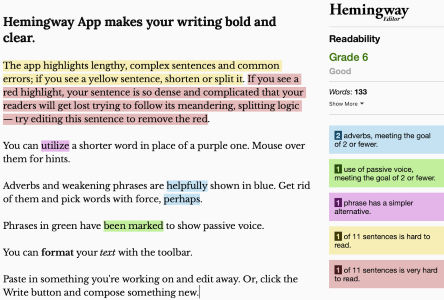6 ways to streamline sentences
If your sentences are too long, readers won’t understand them.

So how can you write shorter sentences? Here are six ways to streamline sentences:
1. Find long sentences.
Paste your message into the Hemingway Editor. It will show you which sentences are hard (yellow highlighting) or very hard (red highlighting) to read.

Then replace complicated sentences with simple sentences, longer sentences with shorter sentences. Separate dependent clauses; change passive into active voice.
Keep working until you’ve cleared all of the colored highlights out of your text.
2. Use more periods.
The story goes that when future columnist James J. Kilpatrick was a young newspaper reporter, he wrote lots of deadly long sentences. Finally, in frustration, the city editor gave Kilpatrick a piece of paper covered with dots.
“These interesting objects, which apparently you have never encountered before, are known as periods,” the editor said. “You would do well to use them.”
We’d all do well to use more periods. Just hear what these experts have to say:
“There’s not much to be said about the period, except that most writers don’t reach it soon enough.”
— William Zinsser, author of On Writing Well
“No iron can pierce the heart with such force as a period put at just the right place.”
— Isaac Bashevis Singer, Nobel Prize-winning author
So scan your copy for punctuation marks other than periods. Those include colons, commas, dashes, ellipses, parentheses, semicolons. These punctuation marks connect dependent and independent clauses together to create sprawling sentences.
These writing pros aren’t fans:
“I like to use as few commas as possible so that sentences will go down in one swallow without touching the sides.”
— Florence King, author of Reflections in a Jaundiced Eye
“Anyone who finds himself putting down several commas close to one another should reflect that he is making himself disagreeable and question whether it is necessary.”
— H.W. Fowler, English lexicographer
“The semicolon is “the only unretweetable punctuation mark.”
— Dan Zarrella, viral marketing scientist, based on his study of 1 million retweets
“My thought for the day is that the semicolon rarely helps a passage; usually it creates little more than clutter. This is my second thought for the day: The semicolon rarely helps a passage. Usually it creates little more than clutter.”
— James J. Kilpatrick, journalist and author of The Writer’s Art
“No semicolons. Semicolons indicate relationships that only idiots need defined by punctuation. Besides, they are ugly.”
— Poet Richard Hugo
When you find commas, dashes, semicolons and other punctuation marks, see whether you can substitute a period instead. As Kilpatrick writes:
“The period, believe me, is the best friend a writer will ever have.”
You would do well to use them.
3. List lists.
If you have a series of three or more items, break them out of the sentence into a bulleted or numbered list. Readers perceive bullets as each being separate sentences and paragraphs.
This is especially important online, where readers skim even more than they do in print. In one test, usability expert Jakob Nielsen made a webpage 47% more usable by breaking copy up and lifting ideas off the page. 1
4. Search and destroy conjunctions.
Another way to shorten sentences is to reduce the number of conjunctions.
Conjunctions glue phrases together into long sentences. So if your sentences are too long, use Microsoft Word’s Find function to search for conjunctions. They include and, or, also, but, so, then and plus.
When one of my writing coachees who wrote deadly long sentences tried this trick, she found 23 ands in a 500-word article. Those are pretty good clues for places to shorten.
When you find conjunctions, see whether you can replace them with a period. Or, instead of replacing them, start your sentence with a conjunction.
5. Pass on prepositions.
Reducing the number of prepositions is another way to shorten your paragraphs.
Because prepositions link words and phrases together, they make sentences longer and harder to understand. Since 1928, researchers have shown that prepositions reduce comprehension (Vogel and Washburne, 1928; Ojemann, 1934; Lorge, 1944; Coleman, 1965; Klare, 1976). 2
Take this sentence, from a Starbuck’s release …
“By far, this is the most angst-ridden decision we have made in my more than 25 years with Starbucks, but we realize that part of transforming a company is our ability to look forward, while pursuing innovation and reflecting, in many cases, with 20/20 hindsight, on the decisions that we made in the past, both good and bad.”
That sentence weighs in at 58 words, glued together with 10 prepositions. As the Rev Up Readership member who called this to my attention said:
“Apparently, someone in their PR department had too many cafe mochas and went a little crazy with the prepositional phrases.”
6. Don’t fix fragments.
Mrs. Webb, your 3rd-grade teacher, probably counseled you to avoid sentence fragments. Mrs. Webb was wrong. Sentence fragments can help you:
- Create drama.
- Make a transition.
- Emphasize an important idea.
- Change the pace of your piece.
- Make your copy sound conversational.
- And, of course, make sentences shorter.
Used strategically, fragments can make your copy tighter and more interesting.
Period.
____
Sources:
[1]Jakob Nielsen and John Morkes, “Concise, SCANNABLE, and Objective: How to Write for the Web,” Nielsen Norman Group, Jan. 1, 1997
[2]William H. DuBay, Smart Language: Readers, Readability, and the Grading of Text, Impact Information, Costa Mesa, California

Leave a Reply